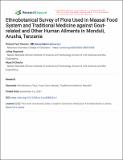| dc.description.abstract | Background: Flora used by Maasai practitioners (MSPs) in traditional medicine (TM) and food system (FS) were investigated in Monduli District, Arusha, Tanzania. The objective of this study was to document the knowledge on flora used by MSPs in their FS and TM against gout-related and other ailments.
Methods: Ethnobotanical knowledge held by 21 MSPs was investigated following standard approaches. Guided field walk, free listing, rigorous individual-interviews and local market surveys were employed to obtain information. Use value (UV) index, relative frequency of citation (RFC), specific RFC (RFCs), fidelity level (FL) and informant consensus factors (ICF) matrices were involved to determine the knowledge on flora used in Maasai FS and TM against gout-related and other ailments.
Results: A total of 101 plant species in 83 genera and 47 families, used in Maasai FS and TM were recorded. Food, food processing or storage, and medicinal plant (MPs) flora accounted 29, 32 and 80 species respectively. MPs treated more than 38 ailments. A high proportion of plants recovered, was trees 45.19%; while 88.79% were retrieved from the wild habitat. Roots were mostly used part (30.73%); preparations were made from fresh or dry material and 44-species involved decoction in meat broth or stock. The frequently route of delivery was oral, 85.19%. About 37.5% of the MPs were used to treat joints’ pain or inflammation (ICF = 0.52) whereas, mostly used was Rapanea melanophloeos (FL = 1.00; RFCs = 0.29) followed by Withania somnifera (FL = 0.5; RFCs = 0.24). Withania somnifera frequently used against other gout-related ailments. Vangueria infausta and Olea europaea subsp. Africana uses in FS ranked the highest.
Conclusion: The study area is very rich in flora biodiversity, and the flora is an integral part of the indigenous foods’ and health care systems. The flora is exposed to various destructive anthropogenic activities; thus, integrated conservation measures are required. The rich ethnobotanical knowledge held by MSPs, requires an in-depth study and documentation. Investigations of flora used in the FS, and TM, with high FL, and RFCs could contribute to future nutraceuticals and drug discovery against gout and other ailments. | en_US |

